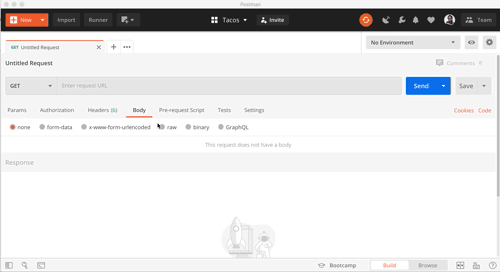

GET url should not exceed the maximum url length i.e.

HEAD: used to know the response identical to that of a GET request without the response body OPTIONS: used to lists down all operations/methods for the target resource (i.e. PUT: used to send data to server to replace a specified resourceĭELETE: used to remove specified resource POST: used to send data to server to create a specified resource GET: used to request data from specified resource Request Body: which has message content/resource representation Metadata could be client type, format supported by the client, format of message, cache settings Request Header - which carries metadata (Key-Value pair) for the HTTP request message. URI - identifier for the source on the server
#POSTMAN GRAPHQL EXAMPLE SOFTWARE#
API is a collection of software functions and procedures. Small example for Microservices/Monolithic ArchitectureĪPI - Application Programming Interface a interface that allows two applications to interact with each other without any user intervention, helps two different applications to communicate and exchange data with each other. Since services are not isolated, individual resource allocation not possible
#POSTMAN GRAPHQL EXAMPLE CODE#
Changes in one module of code affect the other Monolithic architecture is tightly coupled. This allows individual Microservice to adopt a data model best suited for its needs.Ī single code base for all business goalsįault isolation is difficult. Even if one service goes down, other can continue to function.Īll microservices should be loosely coupled so that changes made in one does not affect the other.īusinesses can deploy more resources to services that are generating higher ROIĭata is federated. Monolithic ArchitectureĮvery unit of the entire application should be the smallest, and it should be able to deliver one specific business goal.įault isolation is easy. These modules can be independently deployed It is a software engineering approach that focuses on decomposing an application into single-function modules with well-defined interfaces. That's it! You should now have a fully functioning collection of GraphQL operations that you can use to help improve your developer experience when working with GraphQL APIs.Microservices also known as the microservice architecture which is an architectural style that structures an application as a collection of services that are Now with this file all that's left to do is import it to Postman, or Insomnia. This file will saved to the directory you ran the script inside of. Now you'll have a new folder with a name that looks a little something like: _collection.json You'll be asked to allow net, and write access. Here I'll use the API endpoint in my example: deno run Then all that's left to do is provide the API pointpoint to the Deno script.

#POSTMAN GRAPHQL EXAMPLE INSTALL#
You can do this with Homebrew if you have that installed: brew install deno To get started you'll need to install Deno. GraphMan runs over Deno, and introspects your schema to get all available operations, fields, arguments, variables, and more. GraphMan is a great utility that runs via Deno to automatically convert your GraphQL endpoint to a collection that can be imported to Postman, and Insomnia.


 0 kommentar(er)
0 kommentar(er)
